VI.12.2 Pompeii. Casa del Fauno or House of the Faun.
Linked to VI.12.1, VI.12.3, VI.12.5, VI.12.7 and VI.12.8.
Part 3 Part 4
Part 5 Part 6 Part 7 Part 8 Part 9 Part 10 Part 11 Part 12 Part 1 Part 2 Plan

VI.12.2 Pompeii. September 2021. Looking south from
tablinum 33, across atrium towards entrance. Photo courtesy of Klaus Heese.
VI.12.2 Pompeii. September 2005. Looking south from tablinum 33, across atrium to entrance.
In the upper left can be seen the doorway to the remaining cubiculum 28, in the south-east corner of the atrium.


VI.12.2 Pompeii. Pre 1907 photo by George Washington Wilson.
Looking south from tablinum towards the east side of atrium, as it was prior to the 1943 bombing.
Used with the permission of the Institute of Archaeology, University of Oxford. File name instarchbx208im 128. Source ID. 44453.
See photo on
University of Oxford HEIR database

VI.12.2 Pompeii. 2017/2018/2019. Looking
east across floor in tablinum 33. Photo courtesy of Giuseppe Ciaramella.

VI.12.2 Pompeii. August 2021. Looking north across tablinum
33. Photo courtesy of Robert Hanson.

VI.12.2 Pompeii. October
2020. Looking north across floor in tablinum 33. Photo courtesy of Klaus
Heese.

VI.12.2 Pompeii. May 2015. Looking north across floor in tablinum 33. Photo courtesy of Buzz Ferebee.

VI.12.2 Pompeii. December 2006.
White geometric pattern floor in tablinum 33, with centre paved with pieces of black, white and green stone.

VI.12.2 Pompeii. January 2017. Pilaster on west side of tablinum 33, with room 35, on left.
Foto Annette Haug, ERC Grant 681269
DÉCOR.

VI.12.2 Pompeii. September 2015. Tablinum 33, looking north along west side.
Foto Annette Haug, ERC Grant 681269 DÉCOR.

VI.12.2 Pompeii. January 2017. Tablinum 33, looking towards west wall with windows into room 35.
Foto Annette Haug, ERC Grant 681269 DÉCOR.

VI.12.2 Pompeii. January 2017. Tablinum 33, detail from north-west corner and windows into room 35.
Foto Annette Haug, ERC Grant 681269
DÉCOR.


VI.12.2 Pompeii. January 2017.
Room 33, looking across north wall into Middle Peristyle and through Exedra to Rear Peristyle.
Foto Annette Haug, ERC Grant 681269 DÉCOR.

VI.12.2 Pompeii. January 2017.
Tablinum 33, looking towards north-east corner and east wall with windows into room 34.
Foto Annette Haug, ERC Grant 681269 DÉCOR.

VI.12.2 Pompeii. September 2015.
Looking south-east across tablinum 33, towards east wall, from south portico of Middle Peristyle.
Foto Annette Haug, ERC Grant 681269 DÉCOR.

VI.12.2 Pompeii. January 1977. Looking towards north-east corner of tablinum 33. Photo courtesy of David Hingston.

VI.12.2 Pompeii. Pre-1937-39. Looking north-east across tablinum 33.
Photo courtesy of American Academy in Rome, Photographic Archive. Warsher collection no. 030

VI.12.2 Pompeii. pre-1937-1939. Looking north-east across tablinum 33.
Photo courtesy of American Academy in Rome, Photographic Archive. Warsher collection no. 337.

VI.12.2 Pompeii, 1978. Detail of a ‘cubed’ opus sectile floor. Similar floors exist in the Temple cella of VII.7.32 and VII.7.5. Photo by Stanley A. Jashemski.
Source: The Wilhelmina and Stanley A. Jashemski archive in the University of Maryland Library, Special Collections (See collection page) and made available under the Creative Commons Attribution-Non-Commercial License v.4. See Licence and use details.
J78f0217

Photo courtesy of American Academy in Rome, Photographic Archive. Warsher collection no. 336.

VI.12.2 Pompeii. May 2015. Mosaic border to floor in tablinum 33. Photo courtesy of Buzz Ferebee.

VI.12.2 Pompeii. pre-1937-39. Looking north-west towards tablinum 33 with its mosaic floor.
Photo courtesy of American Academy in Rome, Photographic Archive. Warsher collection no. 1417.

VI.12.2 Pompeii. Mosaic of two tragic masks between a group of flowers, fruits and garlands.
Found in VI.12.2 as a threshold dividing the fauces (room 53) from the atrium, on 28th October 1830.
See Mau, A., 1907, translated by Kelsey F. W. Pompeii: Its Life and Art. New York: Macmillan. (p. 290).
Now in Naples Archaeological Museum. Inventory number 9994.
According to Fiorelli, the tablinum 33 was also separated from the atrium, by a mosaic threshold of masks and garlands.
He described this as reputed to be one of the most stupendous works of art, due to the excellence of the design, colours and workmanship.
See Pappalardo, U., 2001. La Descrizione di Pompei per Giuseppe Fiorelli (1875). Napoli: Massa Editore, (p.71)
See PAH II, 240.

VI.12.2 Pompeii. 1957. Detail from mosaic of two tragic masks, with fruits, flowers and garlands. Photo by Stanley A. Jashemski.
Source: The Wilhelmina and Stanley A. Jashemski archive in the University of Maryland Library, Special Collections (See collection page) and made available under the Creative Commons Attribution-Non-Commercial License v.4. See Licence and use details.
J57f0530

VI.12.2 Pompeii. April 2019. Detail of tragic mask. Photo courtesy of Rick Bauer.

VI.12.2 Pompeii. 1968. Detail from mosaic of fruits, flowers and garlands and two tragic masks. Photo by Stanley A. Jashemski.
Source: The Wilhelmina and Stanley A. Jashemski archive in the University of Maryland Library, Special Collections (See collection page) and made available under the Creative Commons Attribution-Non-Commercial License v.4. See Licence and use details.
J68f1036

VI.12.2 Pompeii. 1968. Detail from centre of mosaic of fruits, flowers and garlands and two tragic masks. Photo by Stanley A. Jashemski.
Source: The Wilhelmina and Stanley A. Jashemski archive in the University of Maryland Library, Special Collections (See collection page) and made available under the Creative Commons Attribution-Non-Commercial License v.4. See Licence and use details.
J68f1037

VI.12.2 Pompeii. 1957. Detail from mosaic of two tragic masks, with fruits, flowers and garlands. Photo by Stanley A. Jashemski.
Source: The Wilhelmina and Stanley A. Jashemski archive in the University of Maryland Library, Special Collections (See collection page) and made available under the Creative Commons Attribution-Non-Commercial License v.4. See Licence and use details.
J57f0531

VI.12.2 Pompeii. April 2019. Detail of tragic mask. Photo courtesy of Rick Bauer.

VI.12.2 Pompeii. 1957. Detail of fruits, flowers and garland from mosaic with two tragic masks. Photo by Stanley A. Jashemski.
Source: The Wilhelmina and Stanley A. Jashemski archive in the University of Maryland Library, Special Collections (See collection page) and made available under the Creative Commons Attribution-Non-Commercial License v.4. See Licence and use details.
J57f0532

VI.12.2/5 Pompeii.
According to this plan –
Mosaic 1 – shows the large Alexander mosaic in the Exedra.
Mosaic 2 – shows a river scene, as the threshold into the room with the Alexander mosaic.
Mosaic 3 – shows a mosaic with fishes (in the dining room on the left of the tablinum).
Mosaic 4 – shows a mosaic with the Genius of Bacchus (in the room on the right of the tablinum).
Mosaic 5 – shows a mosaic with a cat, from the east ala.
Mosaic 6 – shows a mosaic with garlands and masks (in the threshold between the entrance corridor and the atrium).
See Raccolta de più belli ed interessanti Dipinti,
Musaici ed altri monumenti rinvenuti
negli Scavi di Ercolano, di Pompei, e di Stabia. 1871. Napoli,
Tav. 44.

VI.12.2 Pompeii. Between 1867 and 1874.
Looking north across impluvium in atrium, towards tablinum 33. Photo by Sommer and Behles. Photo courtesy of Charles Marty.
Found in the rooms on either side of the tablinum were floor mosaics.
According to Fiorelli, in the room on the left of the tablinum, giving access through to the peristyle, was found a mosaic of Bacchus on a panther.
In the room on the right of the tablinum, was found a floor mosaic of a sea of fishes.
See Pappalardo, U., 2001. La Descrizione di Pompei per Giuseppe Fiorelli (1875). Napoli: Massa Editore, (p.71).

VI.12.2 Pompeii. September 2015.
North-west corner of Primary Atrium, looking towards room 35, on west side of tablinum, on right. West Ala 29 is on the left
Foto Annette Haug, ERC Grant 681269 DÉCOR.

VI.12.2 Pompeii. Pre-1943.
Looking across atrium towards triclinium/dining room 35 on west (left) side of tablinum.
This formed a passageway between the atrium and the middle peristyle/garden.
See Warscher, T. (1946). Casa del Fauno, Swedish Institute, Rome. (p.26, n.33).

VI.12.2 Pompeii. January 2017. Pilaster between doorway to room 35, on left, and tablinum 33, on right.
Foto Annette Haug, ERC Grant 681269
DÉCOR.

VI.12.2 Pompeii. September 2015. Room 35, doorway threshold from atrium, looking north.
Foto Annette Haug, ERC Grant 681269
DÉCOR.

VI.12.2 Pompeii. January 2017. Room 35, detail of flooring and doorway threshold near east wall.
Foto Annette Haug, ERC Grant 681269 DÉCOR.

VI.12.2 Pompeii. January 2017. Room 35, looking north through doorway towards rear doorway to Middle Peristyle, on right.
Foto Annette Haug, ERC Grant 681269 DÉCOR.

VI.12.2 Pompeii. January 2017. Room 35, looking north across flooring.
Foto Annette Haug, ERC Grant 681269
DÉCOR.

VI.12.2 Pompeii. Found in the other of the two dining rooms at the side of the tablinum 33, (either 34 or 35)
Floor mosaic of fishes and marine life. Now in Naples Archaeological Museum. Inventory number 9997.
See Mau, A., 1907, translated by Kelsey F. W. Pompeii: Its Life and Art. New York: Macmillan, (p.292-3).
Found 1st November 1830, see PAH II, 241.
According to Fiorelli, in the room on the left of the tablinum, giving access through to the peristyle, was found a mosaic of Bacchus on a panther.
In the room on the right of the tablinum, was found a floor mosaic of a sea of fishes.
See Pappalardo, U., 2001. La Descrizione di Pompei per Giuseppe Fiorelli (1875). Napoli: Massa Editore, (p.71).

VI.12.2 Pompeii. April 2019.
Floor mosaic emblema of fishes and marine life. Photo courtesy of Rick Bauer.
(According to the information noticeboard from Naples Museum, this mosaic emblema was found in the room on the left of the tablinum 33.)
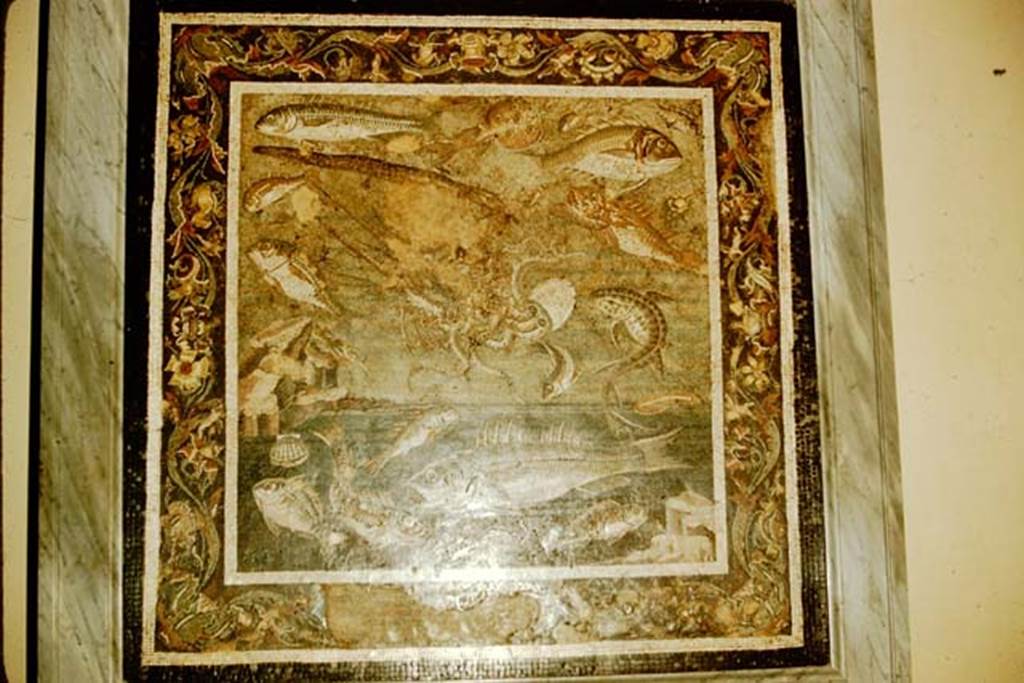
VI.12.2 Pompeii. 1957. Floor mosaic of fishes and marine life. Photo by Stanley A. Jashemski.
Source: The Wilhelmina and Stanley A. Jashemski archive in the University of Maryland Library, Special Collections (See collection page) and made available under the Creative Commons Attribution-Non-Commercial License v.4. See Licence and use details.
J57f0535
Now in Naples Archaeological Museum. Inventory number 9997

VI.12.2 Pompeii. September 2015. Room 35, west wall of dining room.
Foto Annette Haug, ERC Grant 681269
DÉCOR.
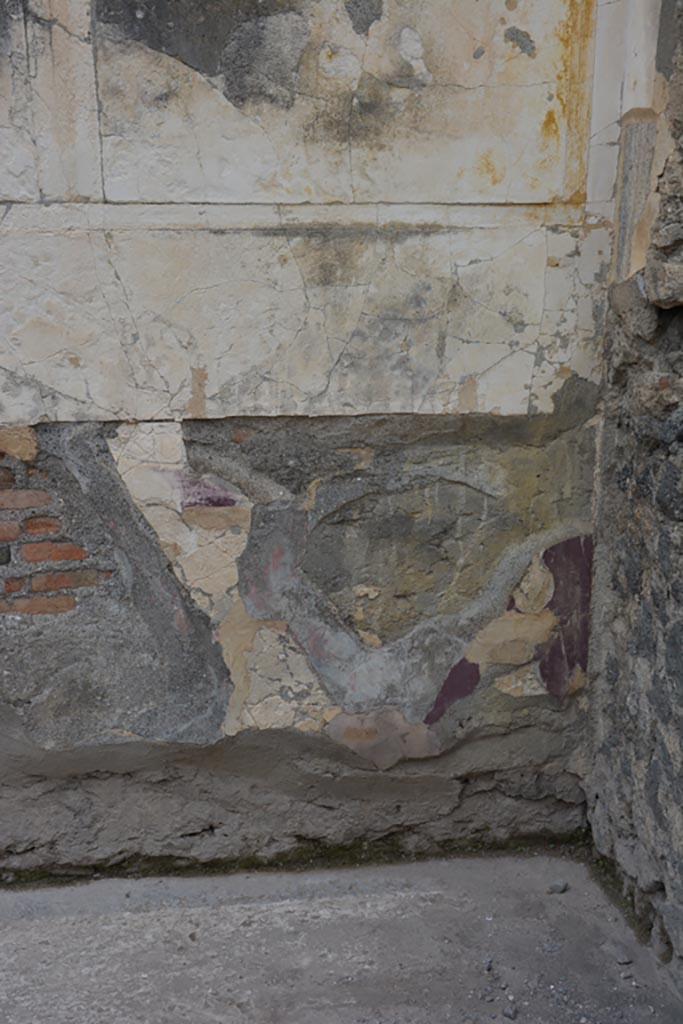
VI.12.2 Pompeii. November 2017. Room 35, west wall in north-west corner of dining room.
Foto Annette Haug, ERC Grant 681269
DÉCOR.

VI.12.2 Pompeii. January 2017. Room 35, lower north-west corner.
Foto Annette Haug, ERC Grant 681269
DÉCOR.
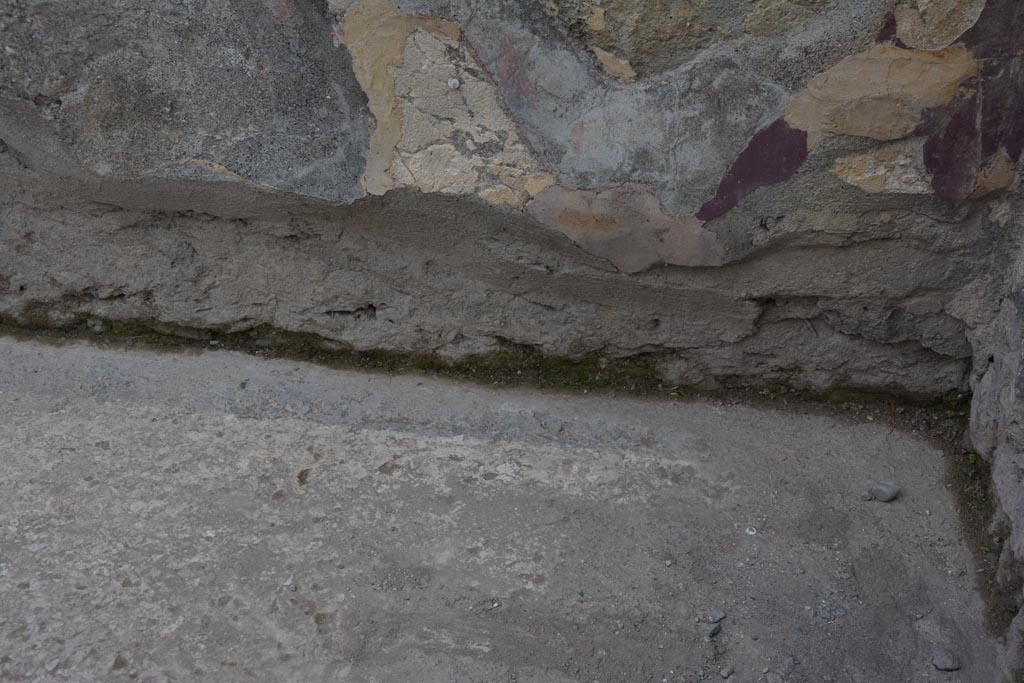
VI.12.2 Pompeii. November 2017. Room 35, detail from lower west wall.
Foto Annette Haug, ERC Grant 681269
DÉCOR.

Looking towards west wall in north-west
corner of triclinium/dining room 35 on west side of tablinum, on the left.
On the right is the west wall in the
south-west corner of the middle peristyle/garden.
Foto Annette Haug, ERC Grant 681269 DÉCOR.

VI.12.2 Pompeii. 4th December 1971.
Looking towards west wall in north-west
corner of triclinium/dining room 35 on west side of tablinum, on the left.
On the right is the west wall in the
south-west corner of the middle peristyle/garden.
Photo courtesy of Rick Bauer, from Dr George
Fay’s slides collection.

VI.12.2 Pompeii. Pre-1943.
Looking towards north-west corner of triclinium/dining room 35 on west (left) side of tablinum.
See Warscher, T. (1946). Casa del Fauno, Swedish Institute, Rome. (p.27, n.35).
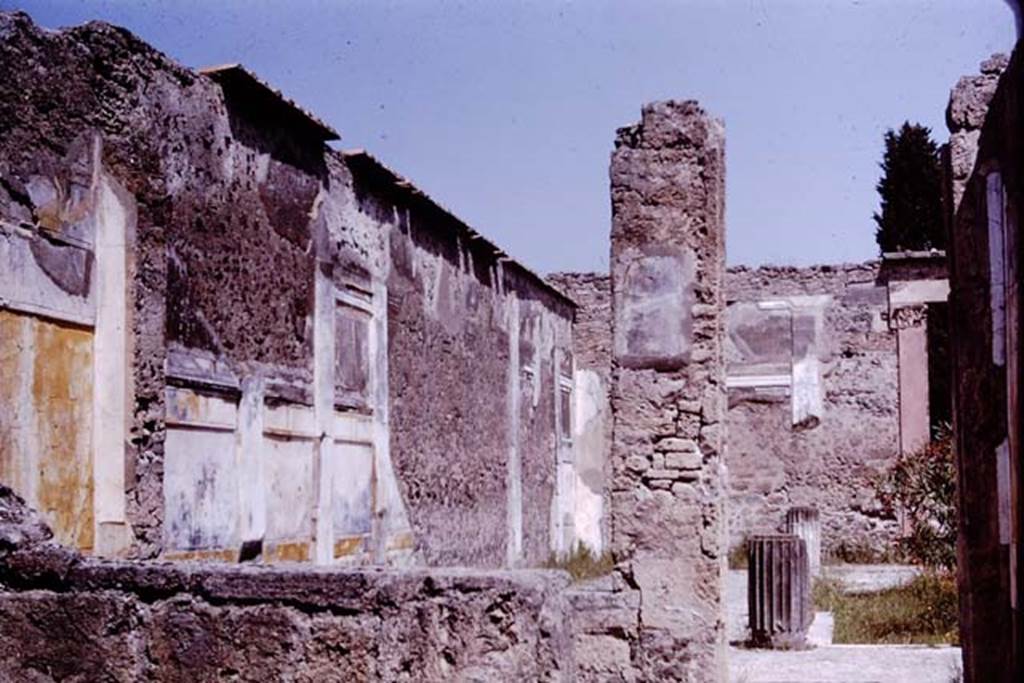
VI.12.2, Pompeii. 1964.
Looking towards dining room 35 on west (left) side of tablinum, and the middle peristyle, with remains of painted decoration on west walls.
Photo by Stanley A. Jashemski.
Source: The Wilhelmina and Stanley A. Jashemski archive in the University of Maryland Library, Special Collections (See collection page) and made available under the Creative Commons Attribution-Non-Commercial License v.4. See Licence and use details.
J64f1085
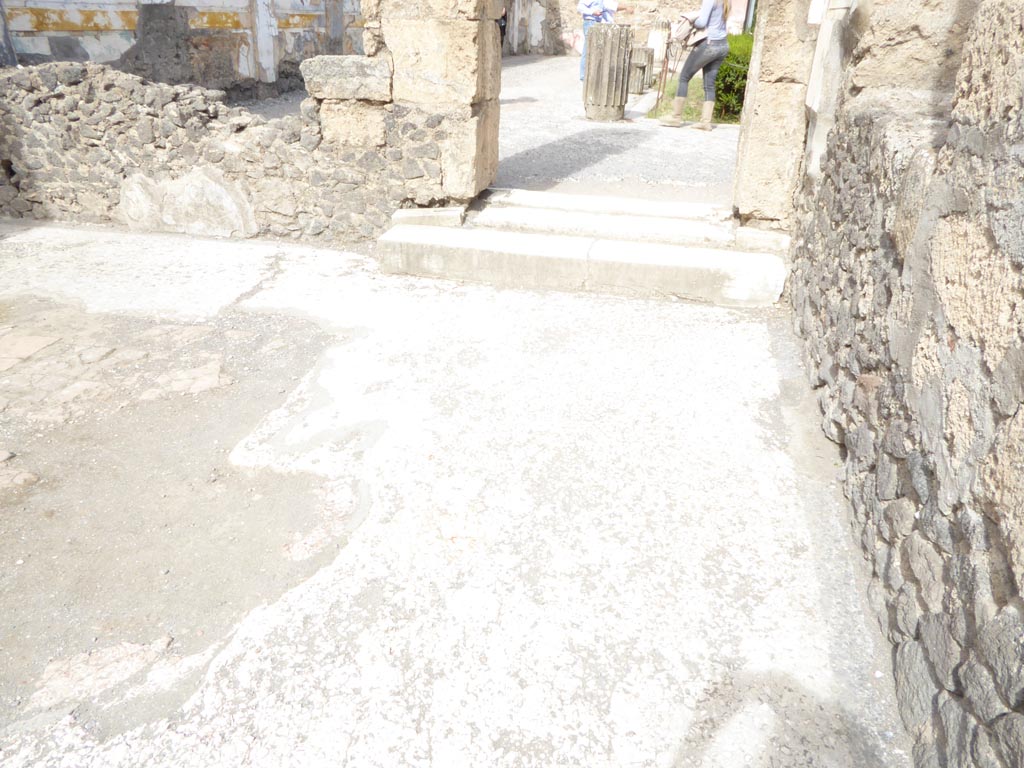
VI.12.2 Pompeii. September 2015. Room 35, looking north across flooring towards doorway to Middle Peristyle.
Foto Annette Haug, ERC Grant 681269
DÉCOR.

VI.12.2 Pompeii. Pre-1943.
Looking towards north-east corner of triclinium/dining room 35, with doorway and step to middle peristyle/garden.
See Warscher, T. (1946). Casa del Fauno, Swedish Institute, Rome. (p.28, n.37).
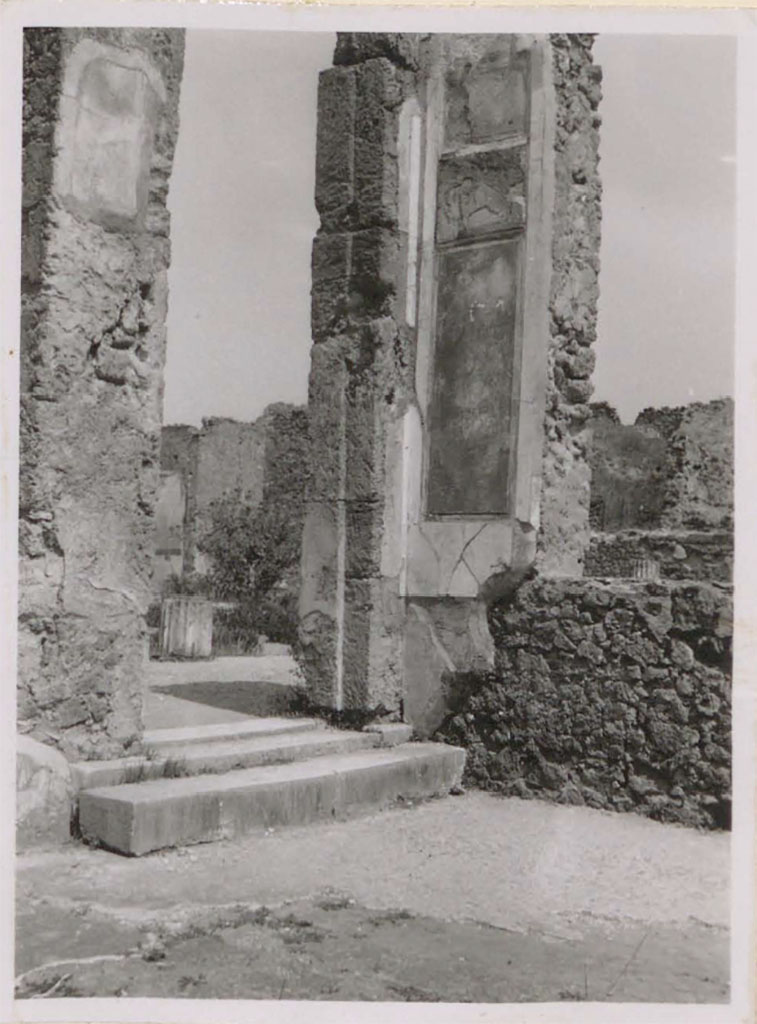
VI.12.2 Pompeii. Pre-1943.
Looking towards north-east corner of triclinium/dining room 35, with doorway and step to middle peristyle/garden.
See Warscher, T. (1946). Casa del Fauno, Swedish Institute, Rome. (p.28, n.38).
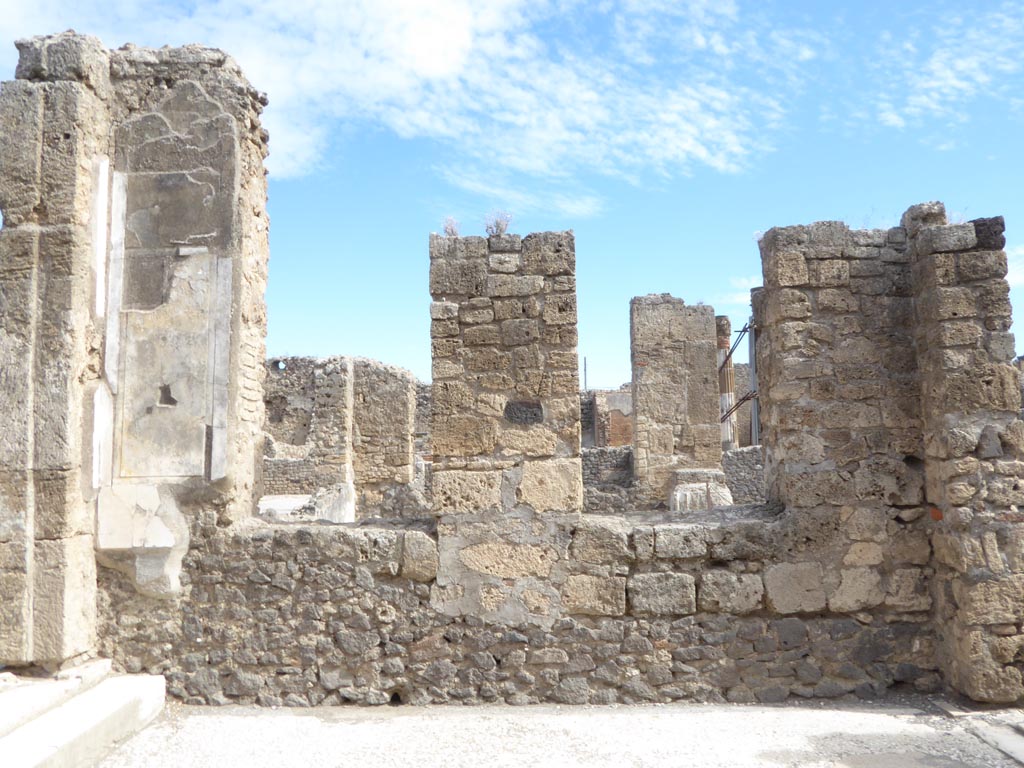
VI.12.2 Pompeii. September 2015. Room 35, east wall of dining room.
Foto Annette Haug, ERC Grant 681269
DÉCOR.

VI.12.2 Pompeii. January 2017. Room 35, detail of east wall of dining room, looking into tablinum.
Foto Annette Haug, ERC Grant 681269
DÉCOR.
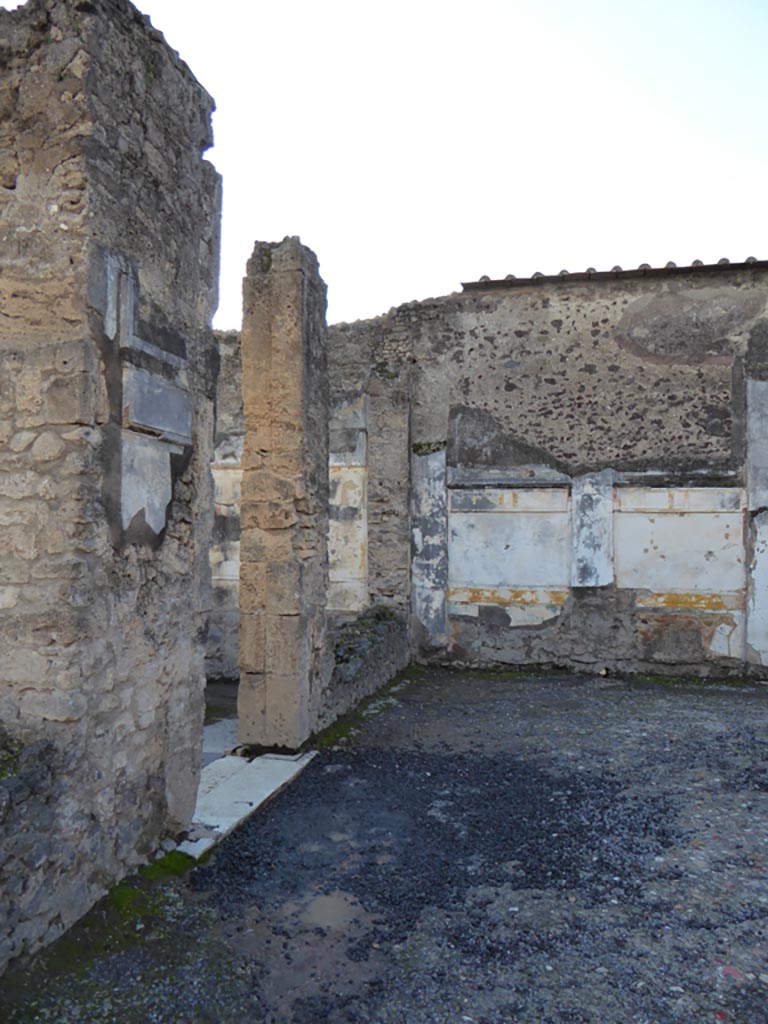
VI.12.2 Pompeii. January 2017.
Looking towards doorway at north end of room 35, at west end of south portico of Middle Peristyle.
Foto Annette Haug, ERC Grant 681269 DÉCOR.
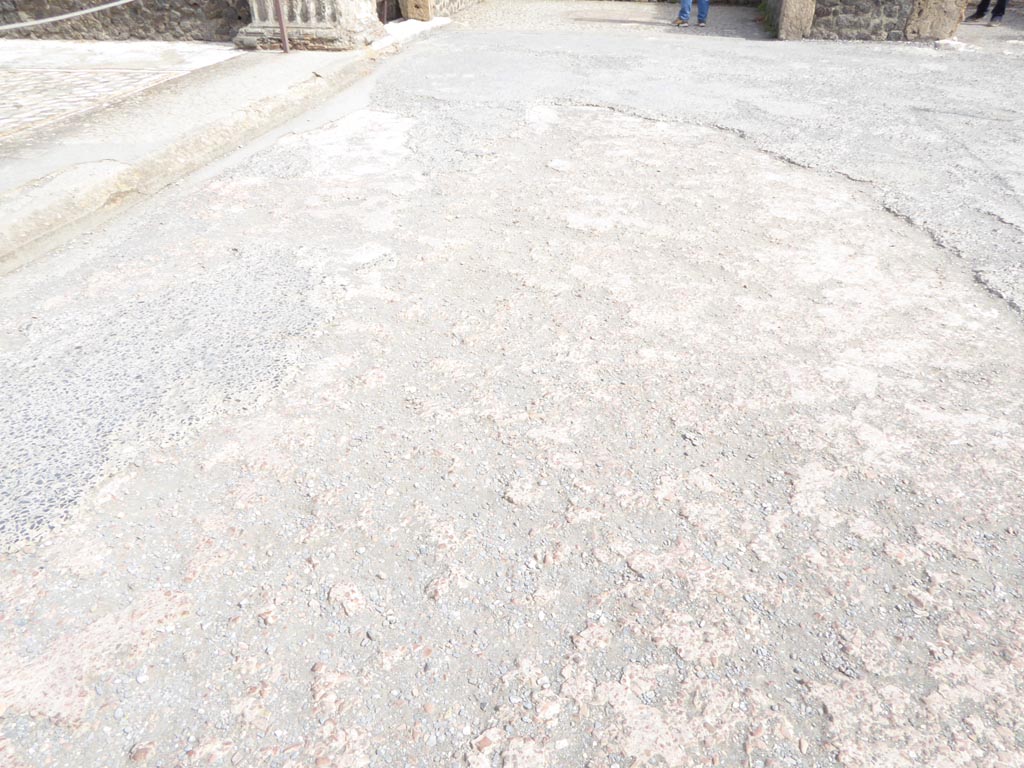
VI.12.2 Pompeii. September 2015. Primary Atrium, looking east across flooring on north side.
Foto Annette Haug, ERC Grant 681269 DÉCOR.
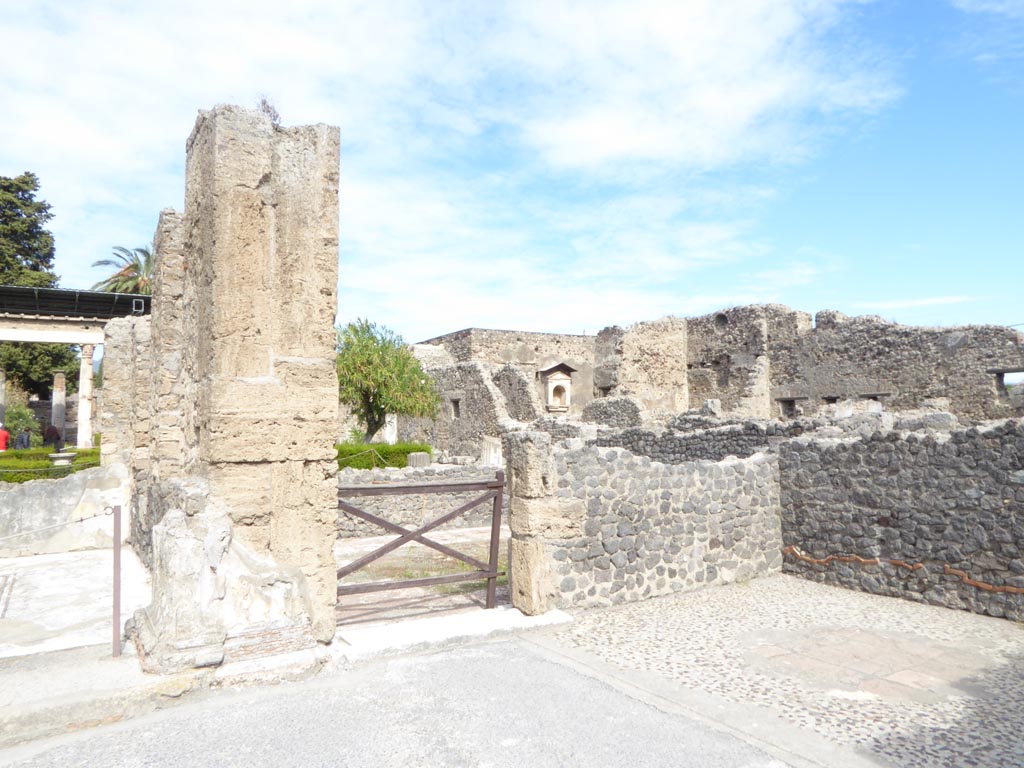
Foto Annette Haug, ERC Grant 681269 DÉCOR.
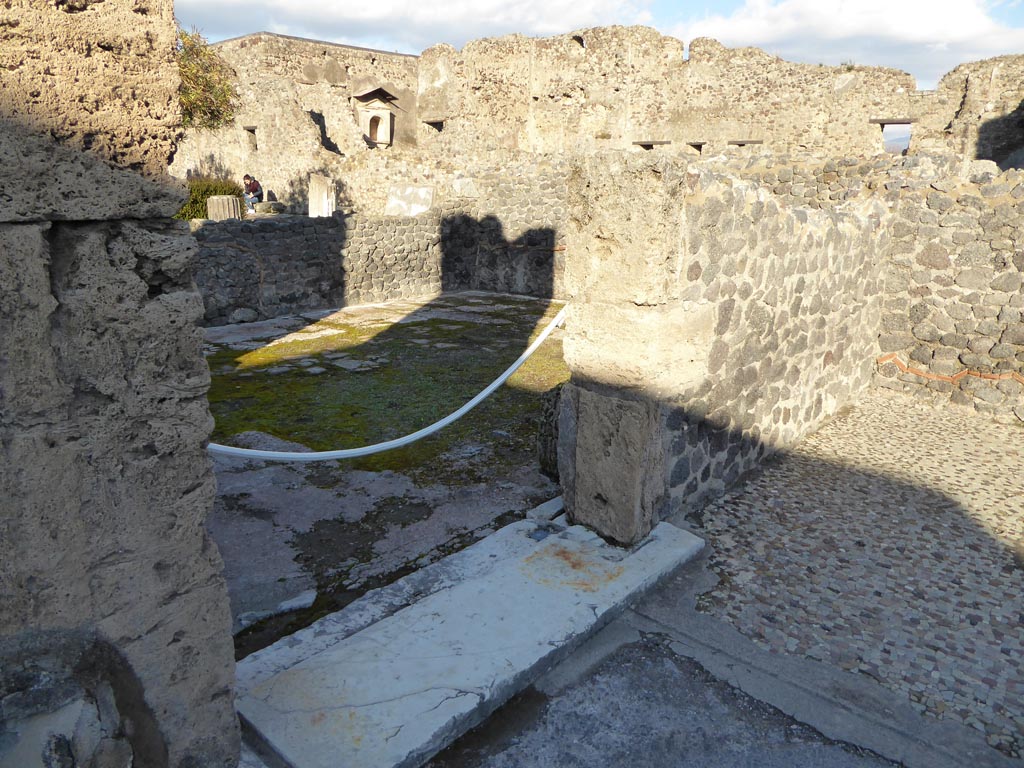
VI.12.2 Pompeii. January 2017. Room 34, doorway in north-east corner of atrium.
Foto Annette Haug,
ERC Grant 681269 DÉCOR.

Foto Annette Haug,
ERC Grant 681269 DÉCOR.
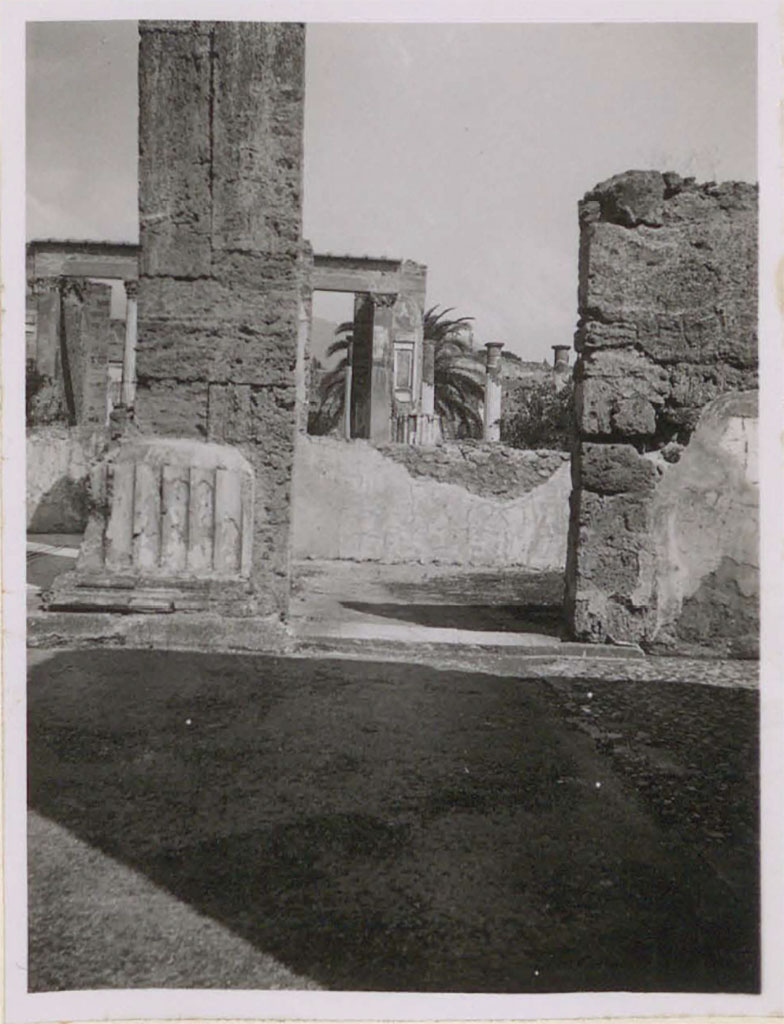
VI.12.2 Pompeii. Pre-1943.
Doorway from north-east corner of atrium towards triclinium 34 on right side of tablinum.
On the right is the east ala 30.
See Warscher, T. (1946). Casa del Fauno, Swedish Institute, Rome. (p.27, n.36).
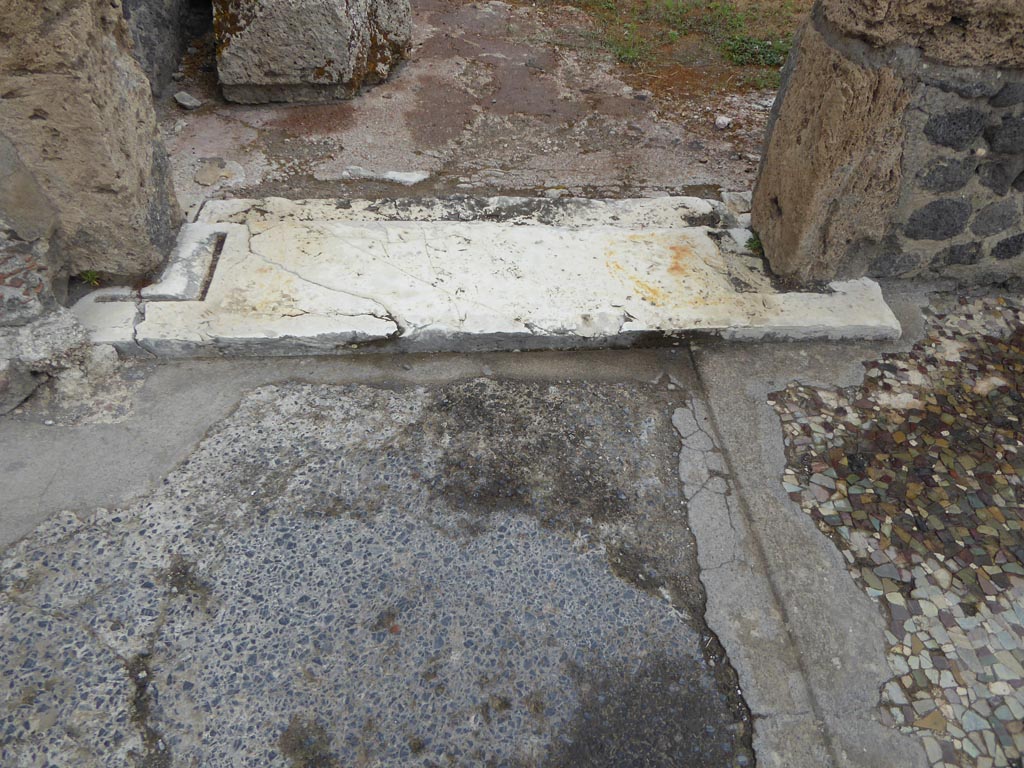
VI.12.2 Pompeii. September 2017. Triclinium 34, doorway threshold on north side of atrium.
Foto Annette Haug, ERC Grant 681269
DÉCOR.

VI.12.2 Pompeii. September 2017. Triclinium 34, detail of west side of doorway threshold.
Foto Annette Haug, ERC Grant 681269
DÉCOR.
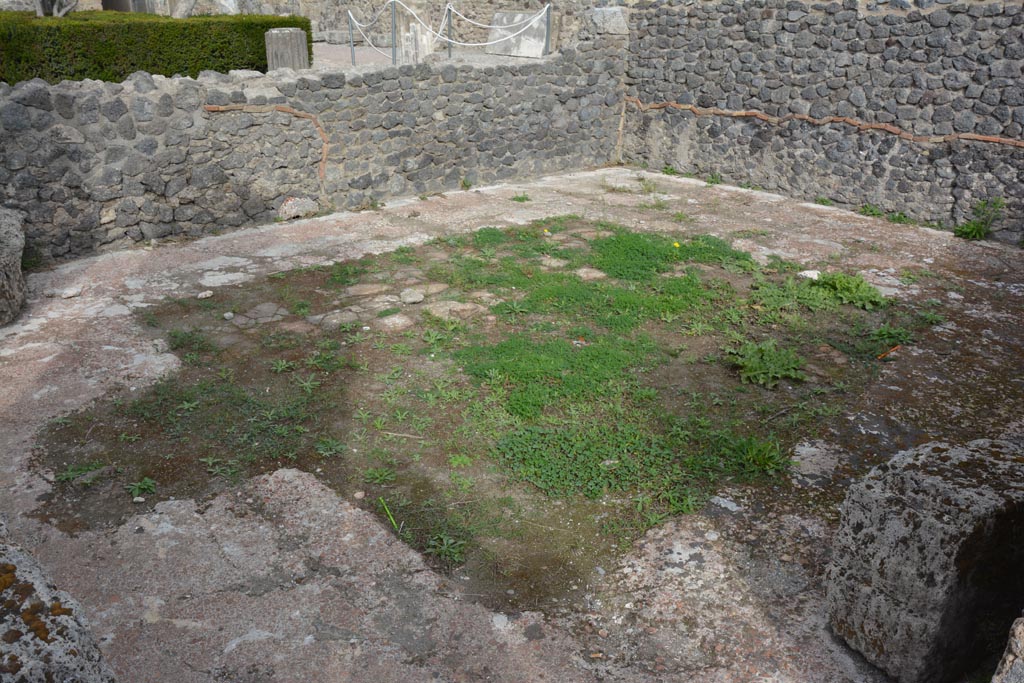
VI.12.2 Pompeii. November 2017. Triclinium 34, looking north-east across flooring, with site of emblema.
Foto Annette Haug, ERC Grant 681269
DÉCOR.
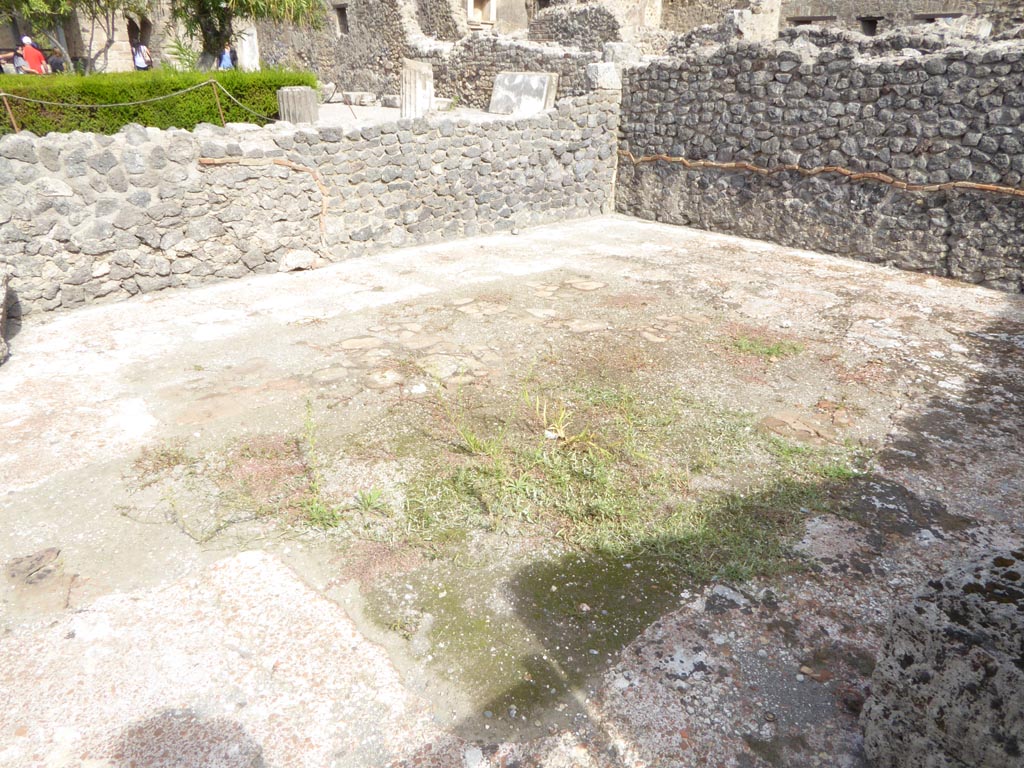
VI.12.2 Pompeii. September 2015. Triclinium 34, looking north-east across flooring.
Foto Annette Haug, ERC Grant 681269
DÉCOR.
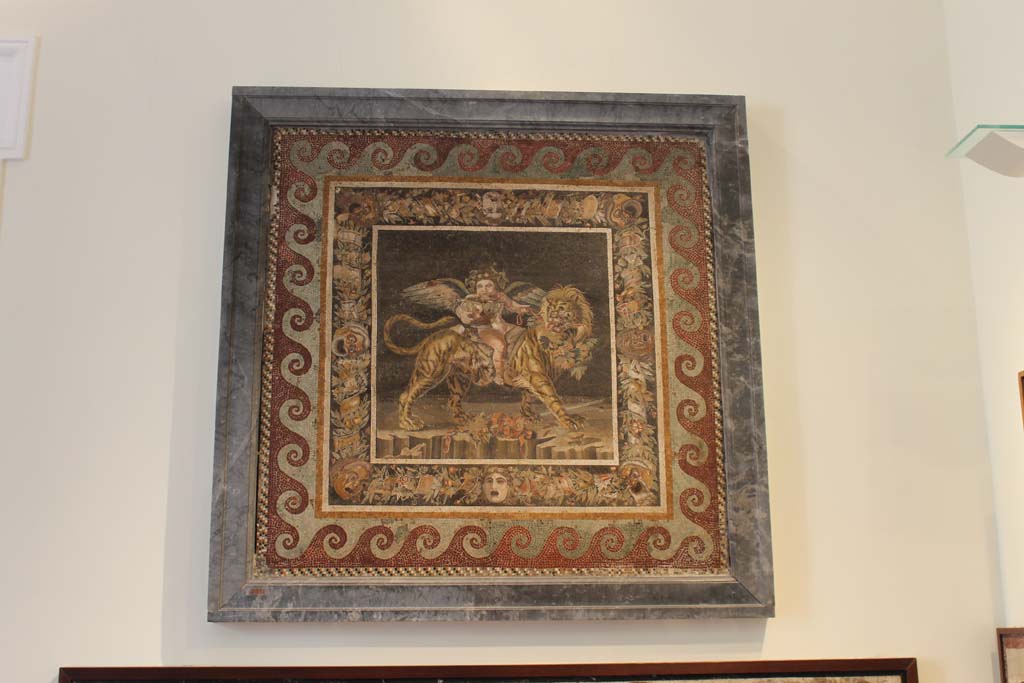
VI.12.2 Pompeii. March 2014. Found in one of the two dining rooms (either 35 or 34) at the sides of the tablinum 33.
Mosaic of the child Dionysus astride an animal with the head of a lion and the body of a tiger.
Now in Naples Archaeological Museum. Inventory number 9991.
Foto Annette Haug, ERC Grant 681269 DÉCOR.
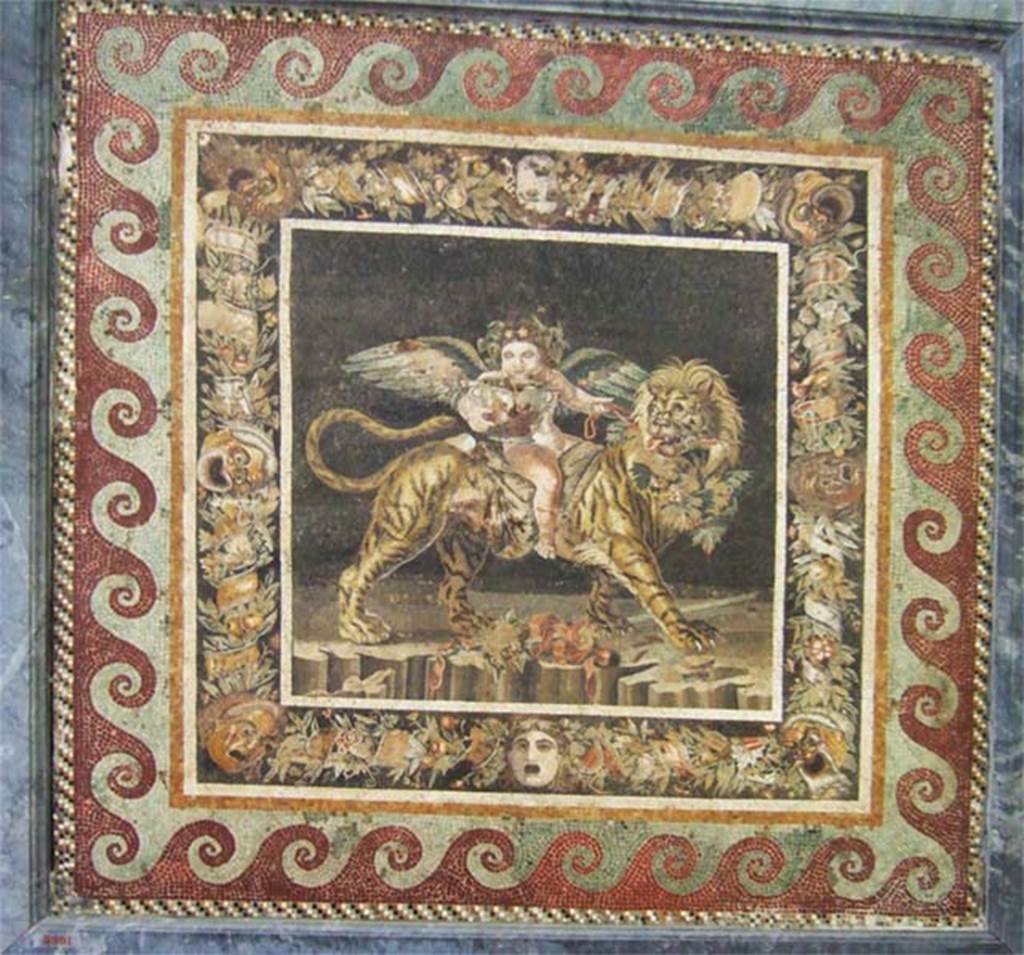
VI.12.2 Pompeii. May 2006. Found in one of the two dining rooms (either 35 or 34) at the sides of the tablinum 33.
Mosaic of the child Dionysus astride an animal with the head of a lion and the body of a tiger.
Mau described it as a floor mosaic of the Genius of the autumn, represented as a vine crowned boy sitting on a panther and drinking out of a deep golden bowl.
See Mau, A., 1907, translated by Kelsey F. W. Pompeii: Its Life and Art. New York: Macmillan. (p.292-3)
Now in Naples Archaeological Museum. Inventory number 9991.
Found 1st December
1830. See Fiorelli G., 1862. Pompeianarum antiquitatum historia, Vol. 2: 1819 - 1860, Naples, p. 242.
According to Fiorelli, in the room on the left of the tablinum, giving access through to the peristyle, was found a mosaic of Bacchus on a panther.
In the room on the right of the tablinum, was found a floor mosaic of a sea of fishes.
See Pappalardo, U., 2001. La Descrizione di Pompei per Giuseppe Fiorelli (1875). Napoli: Massa Editore, (p.71).
(According to the information noticeboard from Naples Museum, this mosaic emblema was found in the room on the right of the tablinum.)
Kuivalainen comments: The potential Bacchus-emblema, a tiger-rider (MANN 9991), is more likely a Genius or a Cupid.
See Kuivalainen, I., 2021. The Portrayal of Pompeian Bacchus. Commentationes Humanarum Litterarum 140. Helsinki: Finnish Society of Sciences and Letters, p. 75 note 352.
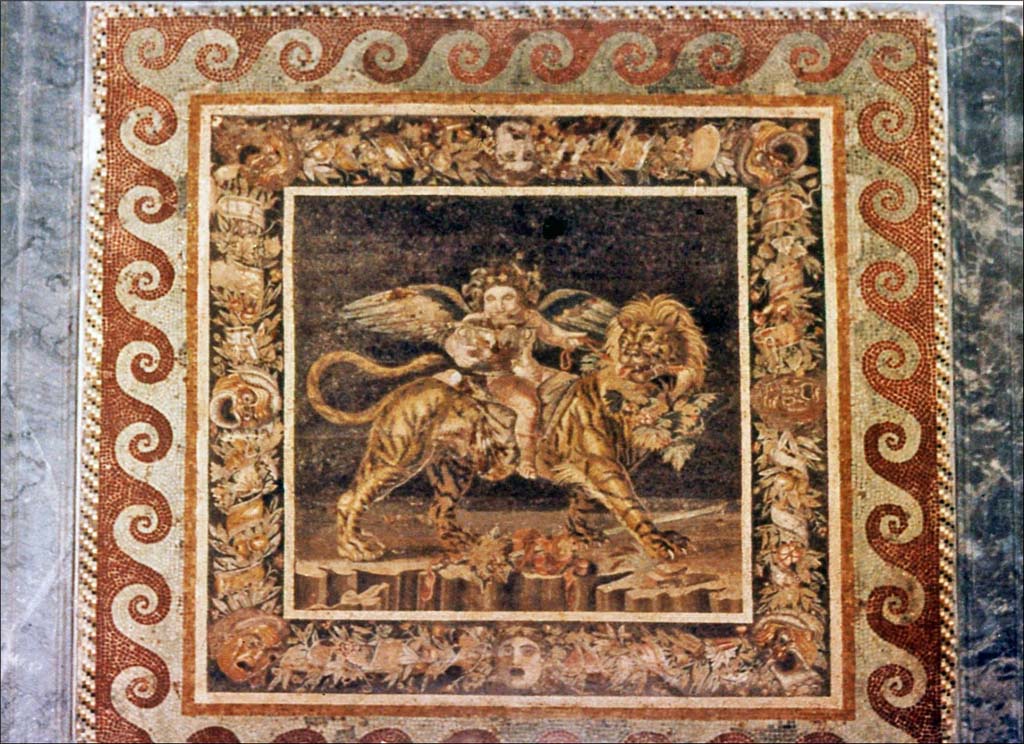
VI.12.2 Pompeii. June 1962.
Photo by Brian Philp: Pictorial Colour Slides, forwarded by Peter Woods
(P43.24 POMPEII House of the Faun Young Dionysius riding an animal with the head of a lion and the body of a tiger.)
Now in Naples Archaeological Museum. Inventory number 9991.
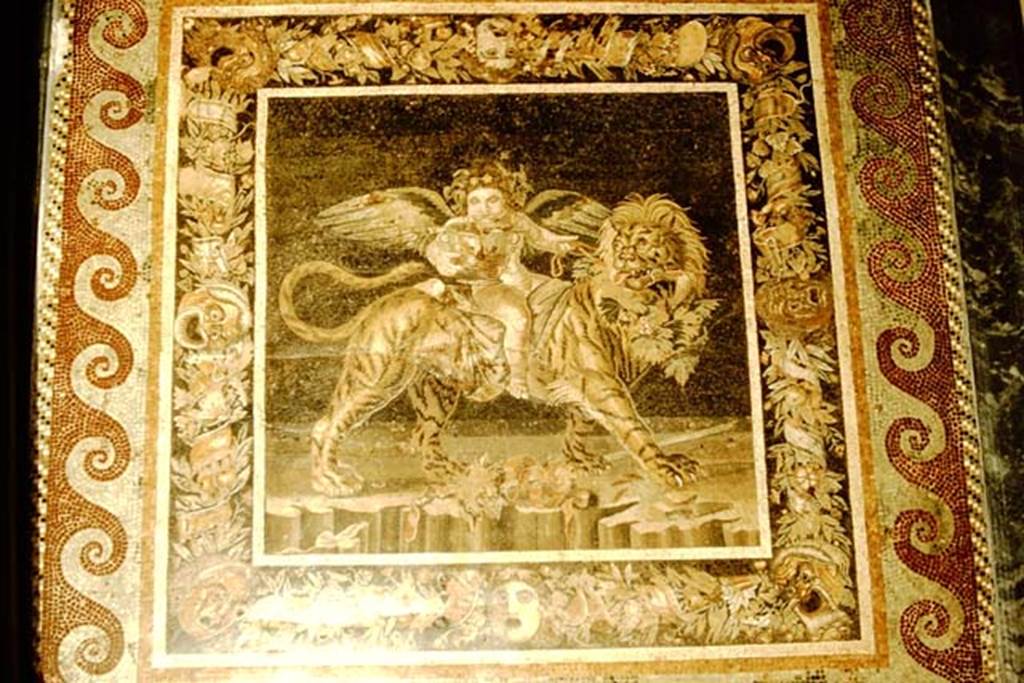
VI.12.2 Pompeii. 1957.
Mosaic of the child Dionysus astride an animal with the head of a lion and the body of a tiger. Photo by Stanley A. Jashemski.
Source: The Wilhelmina and Stanley A. Jashemski archive in the University of Maryland Library, Special Collections (See collection page) and made available under the Creative Commons Attribution-Non-Commercial License v.4. See Licence and use details.
J57f0533
Now in Naples Archaeological Museum. Inventory number 9991.
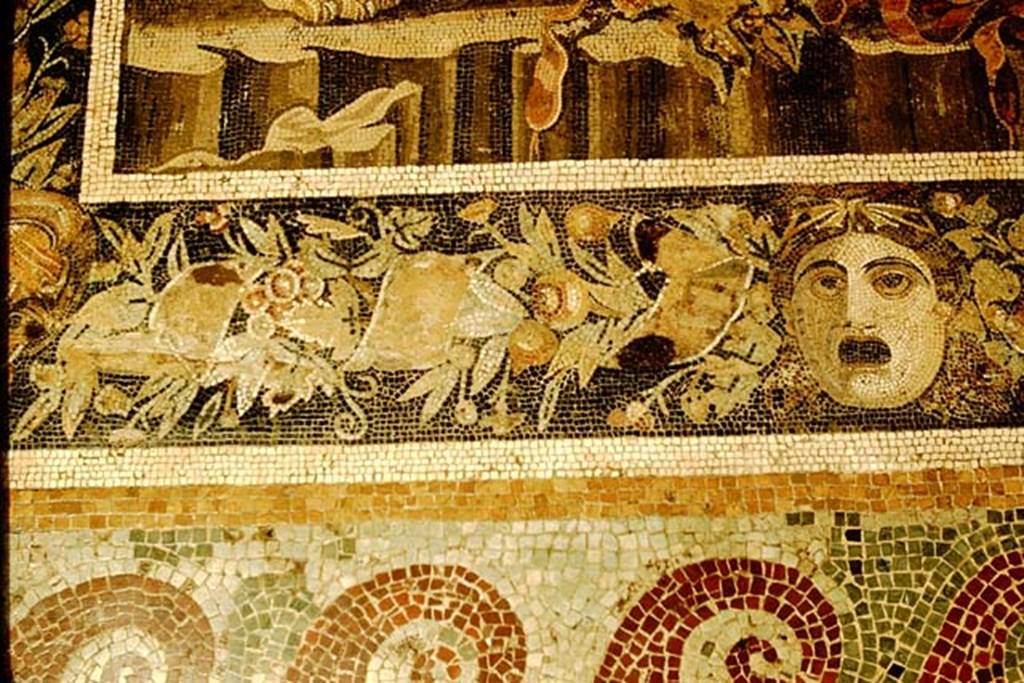
VI.12.2 Pompeii. 1957.
Detail from border of mosaic of the child Dionysus astride an animal. Photo by Stanley A. Jashemski.
Source: The Wilhelmina and Stanley A. Jashemski archive in the University of Maryland Library, Special Collections (See collection page) and made available under the Creative Commons Attribution-Non-Commercial License v.4. See Licence and use details.
J57f0534
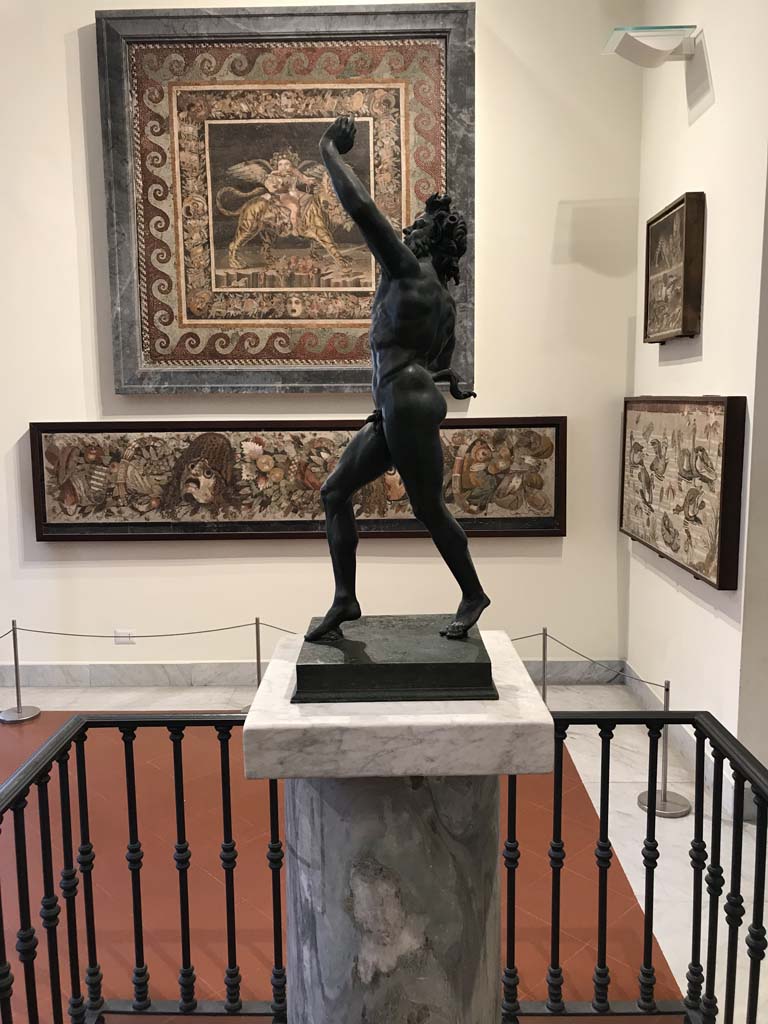
VI.12.2 Pompeii. April 2019. Display of mosaics from the House of the Faun, seen in Naples Museum.
The mosaic of the child Dionysus astride an animal is seen here to demonstrate the size of the floor emblema.
Photo courtesy of Rick Bauer.
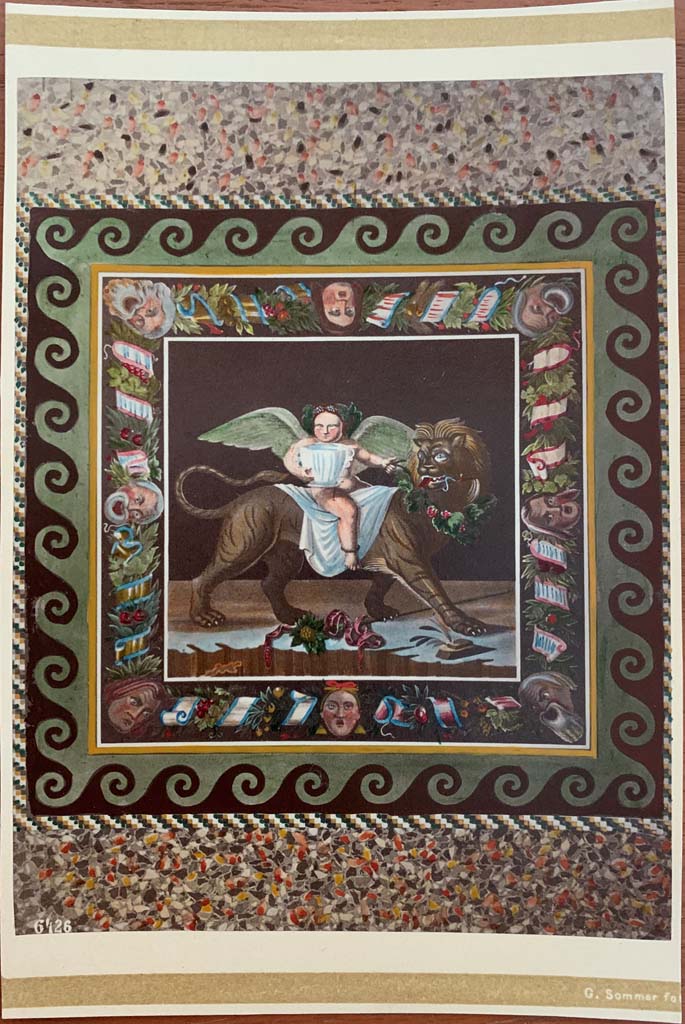
VI.12.2 Pompeii.
Giorgio Sommer Cabinet Card
number 6426. Photo courtesy of Rick Bauer.

VI.12.2 Pompeii.
From an album of Michele Amodio dated 1874, entitled “Pompei, destroyed on 23
November 79, discovered in 1745”.
Mosaic of the child
Dionysus astride an animal. Photo courtesy of Rick Bauer.

VI.12.2 Pompeii. September 2015. Triclinium 34, looking north along west wall.
Foto Annette Haug, ERC Grant 681269
DÉCOR.
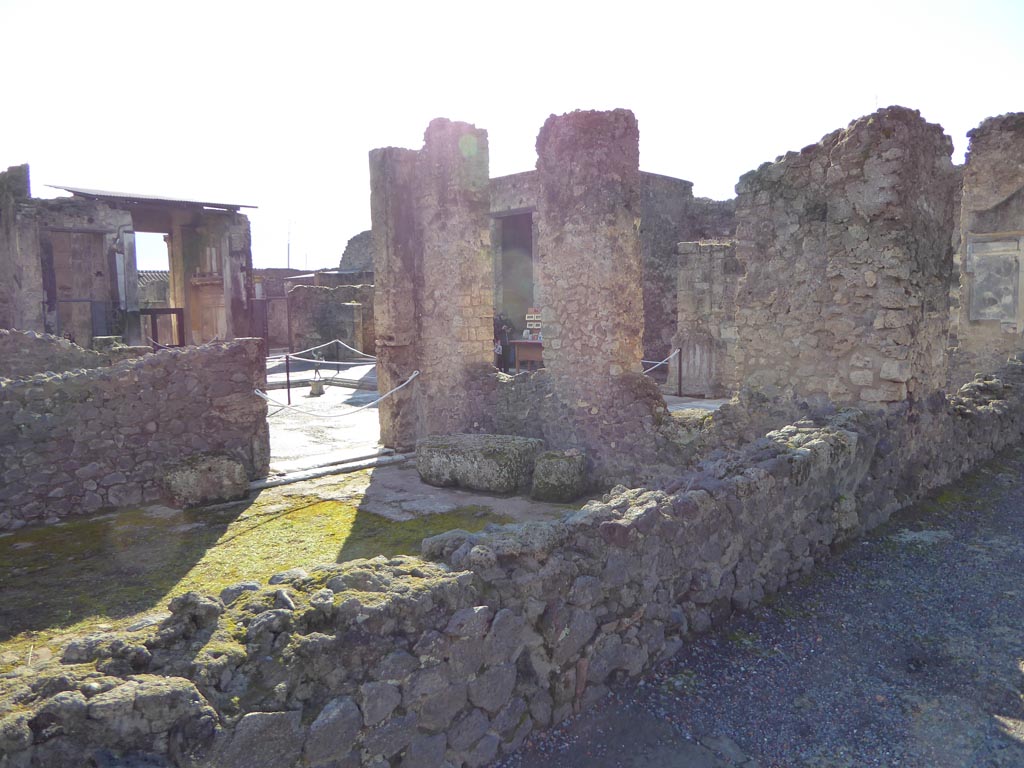
VI.12.2 Pompeii. January 2017. Triclinium 34, looking south-west towards west wall, from Middle Peristyle.
Foto Annette Haug, ERC Grant 681269
DÉCOR.

VI.12.2 Pompeii. January 2017. Triclinium 34, looking south through doorway towards Primary Atrium.
Foto Annette Haug, ERC Grant 681269 DÉCOR.
Part 4 Part 5
Part 6 Part 7 Part
8 Part
9 Part
10 Part
11 Part 12 Part 1
Part 2 Plan
